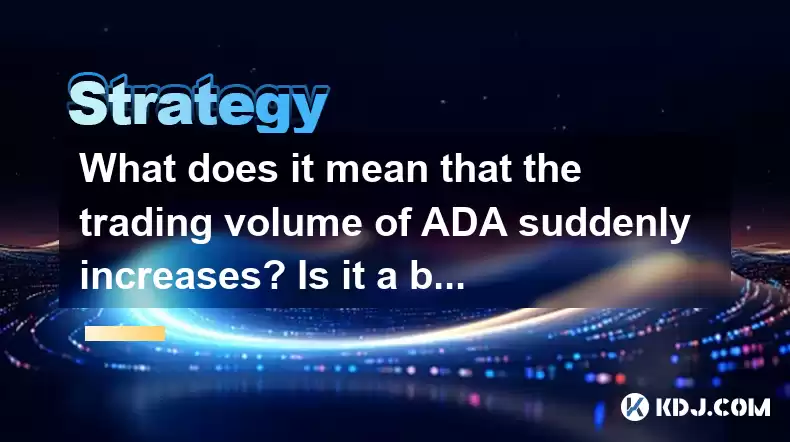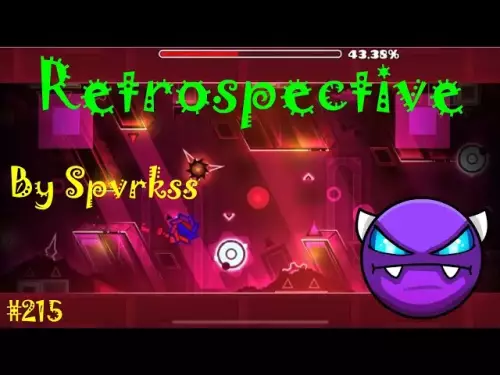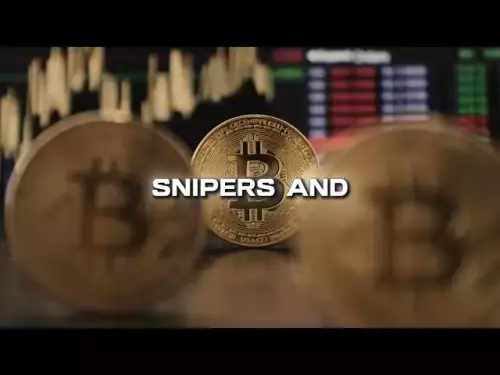-
 bitcoin
bitcoin $108183.343957 USD
1.12% -
 ethereum
ethereum $3953.318181 USD
2.13% -
 tether
tether $1.000758 USD
0.05% -
 bnb
bnb $1102.411872 USD
1.73% -
 xrp
xrp $2.377410 USD
1.30% -
 solana
solana $185.715867 USD
0.05% -
 usd-coin
usd-coin $1.000561 USD
0.08% -
 tron
tron $0.320859 USD
2.39% -
 dogecoin
dogecoin $0.194561 USD
3.07% -
 cardano
cardano $0.647327 USD
2.68% -
 hyperliquid
hyperliquid $37.310392 USD
1.96% -
 ethena-usde
ethena-usde $0.999792 USD
0.04% -
 chainlink
chainlink $17.181017 USD
2.56% -
 stellar
stellar $0.316938 USD
1.13% -
 bitcoin-cash
bitcoin-cash $472.186880 USD
1.35%
What does it mean that the trading volume of ADA suddenly increases? Is it a buy signal?
A sudden increase in ADA's trading volume can signal market interest but isn't a definitive buy signal; consider context and other indicators before deciding.
Apr 29, 2025 at 08:15 am

When the trading volume of Cardano (ADA) suddenly increases, it can signal various things to investors and traders within the cryptocurrency market. Understanding the implications of such a surge in volume is crucial for making informed decisions. This article will delve into what a sudden increase in ADA's trading volume might indicate and whether it should be considered a buy signal.
Understanding Trading Volume in Cryptocurrency
Trading volume refers to the total number of ADA tokens that are bought and sold over a specific period, typically measured in a day. It is a key metric used by traders to gauge the interest and activity in a particular cryptocurrency. A sudden increase in trading volume can be a significant indicator of market sentiment and potential price movements.
Reasons Behind a Sudden Increase in ADA's Trading Volume
There are several reasons why the trading volume of ADA might suddenly increase:
Market News and Announcements: If there is significant news or an announcement related to Cardano, such as a new partnership, technological upgrade, or regulatory development, it can lead to increased trading activity. For instance, if Cardano announces a major update to its blockchain, investors might rush to buy or sell ADA, causing a spike in volume.
Price Movements: A sudden increase in ADA's price can also lead to higher trading volume. If ADA experiences a rapid price surge, it might attract more traders looking to capitalize on the momentum, thereby increasing the volume.
Market Sentiment: Shifts in overall market sentiment can also affect ADA's trading volume. If the broader cryptocurrency market is experiencing a bullish trend, it can lead to increased interest in ADA, resulting in higher trading volumes.
Whale Activity: Large transactions by 'whales' (individuals or entities holding significant amounts of ADA) can also cause sudden spikes in trading volume. If a whale decides to buy or sell a large amount of ADA, it can significantly impact the volume.
Is a Sudden Increase in ADA's Trading Volume a Buy Signal?
Whether a sudden increase in ADA's trading volume should be considered a buy signal depends on various factors and should not be taken as a standalone indicator. Here are some considerations:
Context of the Volume Increase: It's essential to understand the context behind the volume increase. If the surge is due to positive news or developments, it might be a more reliable signal to buy. Conversely, if the increase is due to negative news or a sell-off, it might be a warning sign.
Volume and Price Correlation: Analyzing the correlation between the volume increase and ADA's price movement can provide more insight. If the volume increase is accompanied by a significant price rise, it might indicate strong buying pressure and could be a more convincing buy signal.
Technical Analysis: Traders often use technical analysis to confirm signals. If other technical indicators, such as moving averages or relative strength index (RSI), align with the volume increase, it might strengthen the case for buying ADA.
Market Conditions: The overall market conditions should also be considered. If the broader cryptocurrency market is in a bullish phase, a sudden increase in ADA's volume might be more likely to be a buy signal. However, if the market is bearish, it might be a less reliable indicator.
How to Analyze ADA's Trading Volume
To effectively analyze ADA's trading volume, traders can follow these steps:
Use Trading Platforms: Platforms like Binance, Coinbase, or Kraken provide detailed charts and data on ADA's trading volume. Access these platforms to view real-time and historical volume data.
Compare Volume to Historical Data: Compare the current volume to historical averages to determine if the increase is significant. A volume spike that is several times higher than the average can be more meaningful.
Analyze Volume in Conjunction with Price: Look at how the volume increase correlates with ADA's price movements. A volume increase accompanied by a price rise might indicate strong buying interest.
Consider Multiple Timeframes: Analyze volume across different timeframes, such as daily, weekly, and monthly, to get a comprehensive view of the trend.
Use Volume Indicators: Utilize volume indicators like the Volume Weighted Average Price (VWAP) or the On-Balance Volume (OBV) to gain deeper insights into the volume trends.
Risks of Relying Solely on Volume as a Buy Signal
While a sudden increase in ADA's trading volume can be a useful indicator, relying solely on it as a buy signal can be risky. Here are some potential pitfalls:
False Signals: Volume spikes can sometimes be misleading. For example, a sudden increase in volume might be due to a large sell-off rather than buying interest, leading to a false buy signal.
Market Manipulation: The cryptocurrency market is susceptible to manipulation. A sudden increase in volume might be artificially created by market manipulators to lure in unsuspecting buyers.
Lack of Context: Without considering the broader context, such as market news or technical indicators, a volume increase might not provide a complete picture of the market dynamics.
Volatility: The cryptocurrency market is highly volatile, and sudden volume increases can be followed by equally sudden price drops, leading to potential losses for buyers.
Frequently Asked Questions
Q: Can a sudden increase in ADA's trading volume be a sell signal?A: Yes, a sudden increase in ADA's trading volume can also be a sell signal, especially if it is accompanied by negative news or a significant price drop. It's important to analyze the context and other indicators to determine whether it's a sell signal.
Q: How can I differentiate between a genuine volume increase and market manipulation?A: Differentiating between genuine volume increases and market manipulation can be challenging. Look for consistent volume increases over time, check for corroborating news or announcements, and use multiple indicators to confirm the trend. Be cautious of sudden, unexplained spikes in volume.
Q: Should I use automated trading bots to capitalize on volume increases?A: Automated trading bots can be useful for capitalizing on volume increases, but they come with risks. Ensure that the bot is programmed to consider multiple factors, including volume, price, and technical indicators, and always monitor its performance closely.
Q: How often should I check ADA's trading volume to make informed decisions?A: The frequency of checking ADA's trading volume depends on your trading strategy. For short-term traders, checking volume multiple times a day might be necessary. For long-term investors, weekly or monthly checks might suffice. Always stay updated with market news and trends.
Disclaimer:info@kdj.com
The information provided is not trading advice. kdj.com does not assume any responsibility for any investments made based on the information provided in this article. Cryptocurrencies are highly volatile and it is highly recommended that you invest with caution after thorough research!
If you believe that the content used on this website infringes your copyright, please contact us immediately (info@kdj.com) and we will delete it promptly.
- Japan, FSA, and Bitcoin: A New Era Dawns?
- 2025-10-21 07:05:12
- Paper Rarities Soar at Stack's Bowers: A Look at Recent US Auctions
- 2025-10-21 06:25:13
- PayPal's $300 Trillion Oops: A Glitch in the Matrix?
- 2025-10-21 06:45:16
- Lorna Shore, Sleep Token, and the Hype Machine: What's the Buzz?
- 2025-10-21 06:45:16
- MAGACOIN Finance: Riding the Crypto Presale Wave to Potential 100x Gains
- 2025-10-21 07:05:12
- Cardano Price Rebound: ADA Eyes $1 as Bitcoin Stabilizes
- 2025-10-21 07:10:01
Related knowledge

Practical parameter settings for a Bitcoin multi-timeframe moving average system
Sep 18,2025 at 10:54pm
Optimizing Timeframe Combinations for Bitcoin Trading1. Selecting appropriate timeframes is crucial when building a multi-timeframe moving average sys...

How can I filter out false breakouts in Dogecoin high-frequency trading?
Sep 22,2025 at 01:00am
Understanding False Breakouts in Dogecoin Trading1. A false breakout occurs when Dogecoin's price appears to move beyond a defined support or resistan...

Techniques for identifying tops and bottoms in the Bitcoin on-chain NVT model
Sep 20,2025 at 07:54pm
Understanding the NVT Model in Bitcoin Analysis1. The Network Value to Transactions (NVT) ratio is often described as the 'P/E ratio' of the cryptocur...

What does the surge in open interest in Bitcoincoin futures mean?
Sep 20,2025 at 11:18pm
Understanding the Surge in Dogecoin Futures Open Interest1. A surge in open interest within Dogecoin futures indicates a growing number of active cont...

How can I use the Ethereum USDT premium to gauge market sentiment?
Sep 18,2025 at 11:55pm
Understanding the Ethereum USDT Premium1. The Ethereum USDT premium refers to the price difference between USDT (Tether) traded on Ethereum-based plat...

What should I do if Ethereum staking yields decline?
Sep 20,2025 at 06:18am
Understanding the Causes Behind Declining Ethereum Staking Yields1. The Ethereum network transitioned to a proof-of-stake consensus mechanism with the...

Practical parameter settings for a Bitcoin multi-timeframe moving average system
Sep 18,2025 at 10:54pm
Optimizing Timeframe Combinations for Bitcoin Trading1. Selecting appropriate timeframes is crucial when building a multi-timeframe moving average sys...

How can I filter out false breakouts in Dogecoin high-frequency trading?
Sep 22,2025 at 01:00am
Understanding False Breakouts in Dogecoin Trading1. A false breakout occurs when Dogecoin's price appears to move beyond a defined support or resistan...

Techniques for identifying tops and bottoms in the Bitcoin on-chain NVT model
Sep 20,2025 at 07:54pm
Understanding the NVT Model in Bitcoin Analysis1. The Network Value to Transactions (NVT) ratio is often described as the 'P/E ratio' of the cryptocur...

What does the surge in open interest in Bitcoincoin futures mean?
Sep 20,2025 at 11:18pm
Understanding the Surge in Dogecoin Futures Open Interest1. A surge in open interest within Dogecoin futures indicates a growing number of active cont...

How can I use the Ethereum USDT premium to gauge market sentiment?
Sep 18,2025 at 11:55pm
Understanding the Ethereum USDT Premium1. The Ethereum USDT premium refers to the price difference between USDT (Tether) traded on Ethereum-based plat...

What should I do if Ethereum staking yields decline?
Sep 20,2025 at 06:18am
Understanding the Causes Behind Declining Ethereum Staking Yields1. The Ethereum network transitioned to a proof-of-stake consensus mechanism with the...
See all articles










































































